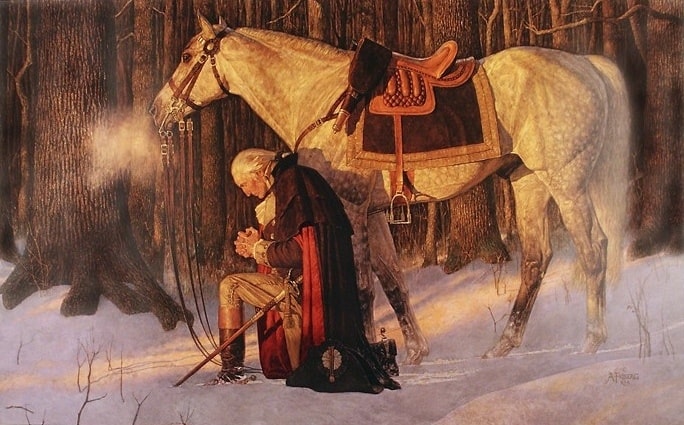Contents
Contents

Painted in 1975, The Prayer at Valley Forge depicts George Washington making a solitary prayer, during the Continental Army’s winter encampment in 1777-78 at Valley Forge, PA.
Historical context
During the Revolutionary War, it was common for both sides to set up camp and wait out the winter, because it was too cold to fight in most of the northern colonies.
In December 1777, Washington led the Continental Army to set up camp near the town of Valley Forge, PA, near Philadelphia, after defeat by the British at the Battle of Brandywine.
The area was on a plateau, meaning it was a difficult location for the British Army to attack, especially during winter. Washington needed a place for his army to recuperate after their recent defeats.
The problem was, the British had raided the encampment a few months prior, taking supplies and destroying buildings. Compounded with existing Continental Army logistical issues, this left Washington with few supplies during a brutally harsh winter. His men had to build their own log cabins as soon as they reached the camp, despite the freezing conditions.
Of the 12,000 people that made the journey to Valley Forge, it is estimated that about 1,000 died due to cold, hunger, and disease.
The winter at Valley Forge was arguably the darkest hour of the Continental Army. Only through Washington’s leadership, and the resolve of his men, did his forces survive the winter of 1777-78.
Today, Valley Forge is considered an important symbol of American strength and resilience, as the scene of a crucial turning point for the Continental Army. The area became a national park in 1976.
The painting
The Prayer at Valley Forge was created to celebrate the bicentennial of the United States.
To ensure accuracy, Friberg, an American Artist, studied Washington’s actual uniform at the Smithsonian Institution and sketched during the winter near the banks of the Schuylkill River at Valley Forge, PA.
“It was a cold that chilled to the bone”, he said, “a cold that froze my fingers until I could no longer sketch nor even snap my camera.”
Friberg chose to focus on Washington’s faith in producing this painting, making his prayer the subject of his work.
Most historians believe that Washington was an Anglican Christian, as he was a member of the Anglican Church, and came from an Anglican family.
However, there is much controversy surrounding Washington’s exact religious beliefs, as he did not discuss his faith publicly, and made very few references to religion in private correspondence.
Despite this, it is accepted that prayer played an important role in Washington’s life. He is known to have prayed every day, by some accounts every morning and evening.
Reaction and significance
This painting was well-received, and is currently one of the most popular depictions of life in the Valley Forge encampment.
It is also considered one of the most iconic paintings of the American Revolution, despite being painted relatively recently compared to other important works like Washington Crossing the Delaware.
The Prayer at Valley Forge does a fantastic job capturing the pressure on Washington, and his resolve, in the perilous situation he and his men found themselves in during the winter at Valley Forge.
Currently, the painting is held at the National Portrait Gallery in Washington, D.C.

